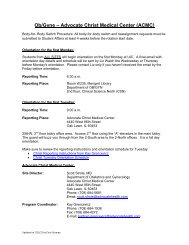View Annual Report 2012 - University of Illinois College of Medicine ...
View Annual Report 2012 - University of Illinois College of Medicine ...
View Annual Report 2012 - University of Illinois College of Medicine ...
You also want an ePaper? Increase the reach of your titles
YUMPU automatically turns print PDFs into web optimized ePapers that Google loves.
COrNeAL SteM CeLLS<br />
Transplants open a window<br />
on the future<br />
For 43-year-old Shawn Doyle, gradually<br />
losing the sight in his right eye was like<br />
looking out on the world “through a dirty<br />
window or wax paper.”<br />
His worsening vision — caused by<br />
a deficiency <strong>of</strong> corneal limbal stem<br />
cells — made it harder to do his work as<br />
a motorcycle and boat mechanic, enjoy<br />
outdoor sports or even drive.<br />
Then, Ali Djalilian, MD, told him<br />
about a limbal stem cell transplant. “I<br />
was intrigued and excited,” says Shawn.<br />
“Over the last 10 years, we’ve been<br />
learning more and more about the<br />
concept <strong>of</strong> limbal stem cell transplants<br />
and improving on the outcomes,” says<br />
Dr. Ali Djalilian, Associate Pr<strong>of</strong>essor<br />
and Director, Corneal Epithelial Stem<br />
Cell Biology and Tissue Engineering<br />
Laboratory.<br />
Limbal stem cells are found at the<br />
edge <strong>of</strong> the cornea. Injuries and genetic<br />
or immunological diseases can destroy<br />
the surface and, with it, limbal stem cells.<br />
The result is visual impairment or even<br />
blindness. The problem can’t be solved<br />
with a standard cornea transplant, which<br />
contains no stem cells.<br />
Surgeons harvest the cells and<br />
surrounding environment from various<br />
sources: the patient’s other eye, if healthy;<br />
a living relative; and cadaver tissue, the<br />
source <strong>of</strong> Shawn’s new stem cells.<br />
Dr. Djalilian’s latest innovation is<br />
the use <strong>of</strong> a biological glue made from<br />
proteins in the blood clotting system<br />
to secure the transplant without any<br />
sutures. The glue has been used in<br />
other forms <strong>of</strong> surgery, but not limbal<br />
transplants. The result is increased<br />
comfort for the patient and less<br />
inflammation.<br />
The program’s approach to medical<br />
management after transplant also<br />
“distinguishes us from other centers,”<br />
says Dr. Djalilian. That includes careful<br />
use <strong>of</strong> immunosuppressants to control<br />
rejection. Often, specialists in glaucoma,<br />
oculoplastics and organ transplant join<br />
the team, as needed.<br />
Since his stem cell transplant in<br />
November, Shawn’s eyesight has<br />
One Vision <strong>2012</strong> 3<br />
Corneal stem cells, pictured here, are<br />
used to grow cells in the laboratory to<br />
study their protein expression and cellto-cell<br />
communications that contribute<br />
to their function.<br />
been improving daily. He can read a<br />
newspaper without the aid <strong>of</strong> glasses<br />
or contact lenses. “It’s been a great<br />
miracle,” he says.<br />
Working in the lab, Dr. Djalilian and<br />
his colleagues are hoping for another<br />
breakthrough: finding a way to replace<br />
limbal stem cells with a patient’s own<br />
cells from elsewhere in the body. Using<br />
a patient’s own cells would eliminate the<br />
problems <strong>of</strong> transplant rejection and<br />
immunosuppression.<br />
So far, the investigators have<br />
succeeded in getting other cells to<br />
change into limbal cells — but the switch<br />
is temporary. One theory is that the cells<br />
need the entire corneal environment<br />
to mimic limbal cells. “That’s the main<br />
focus <strong>of</strong> our research now,” says Dr.<br />
Djalilian, “recreating that environment,<br />
‘the limbal stem cell niche.’”


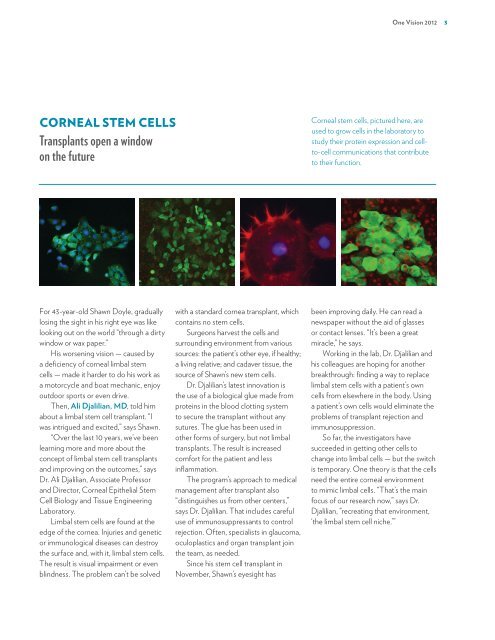
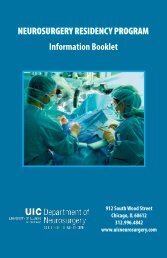
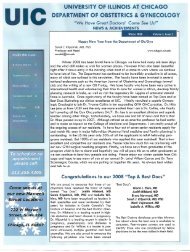
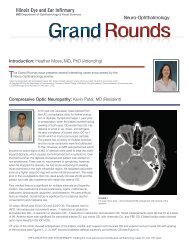
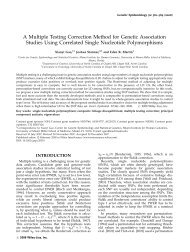

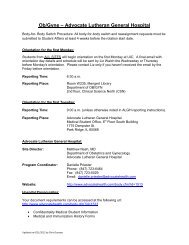



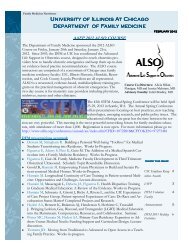
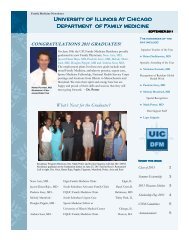
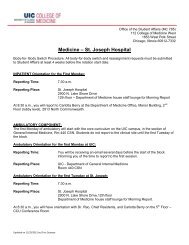
![CV Joan [W51] - University of Illinois College of Medicine at Chicago ...](https://img.yumpu.com/17336863/1/190x245/cv-joan-w51-university-of-illinois-college-of-medicine-at-chicago-.jpg?quality=85)
